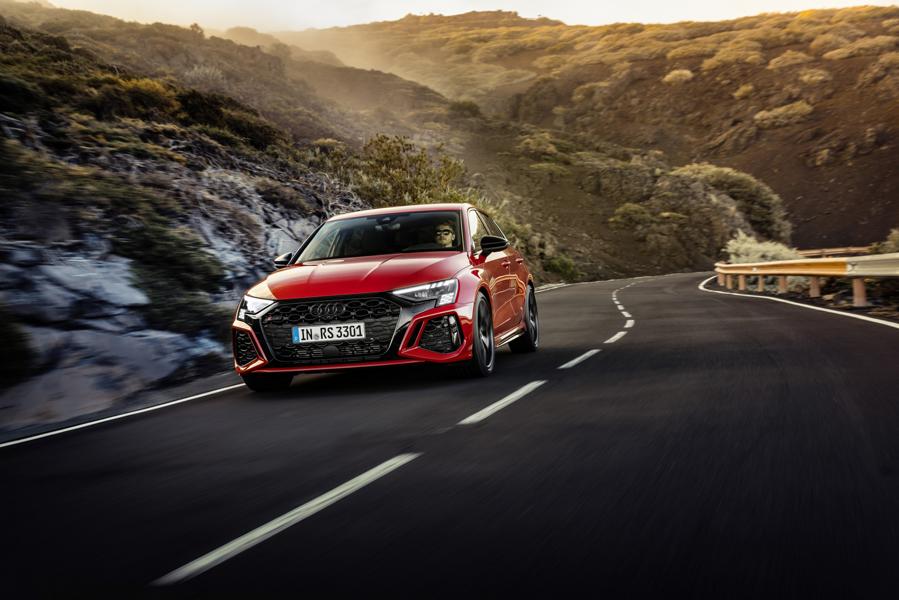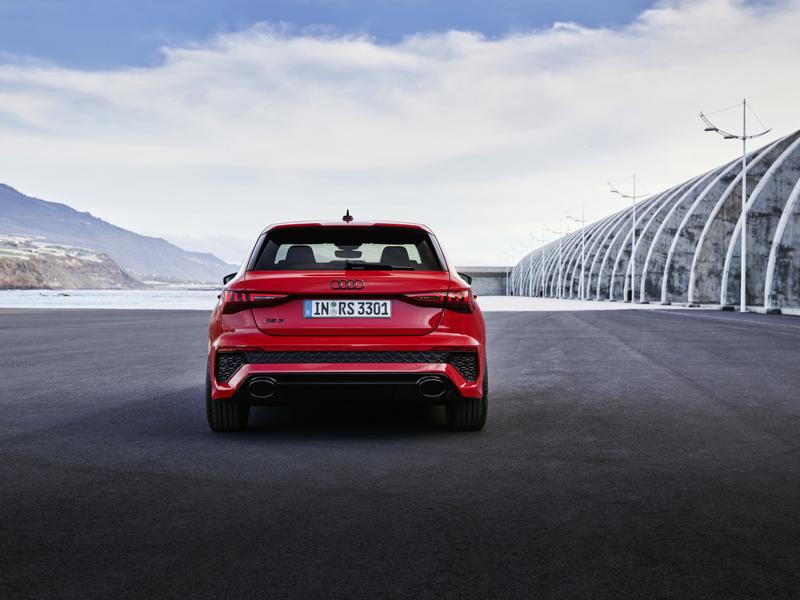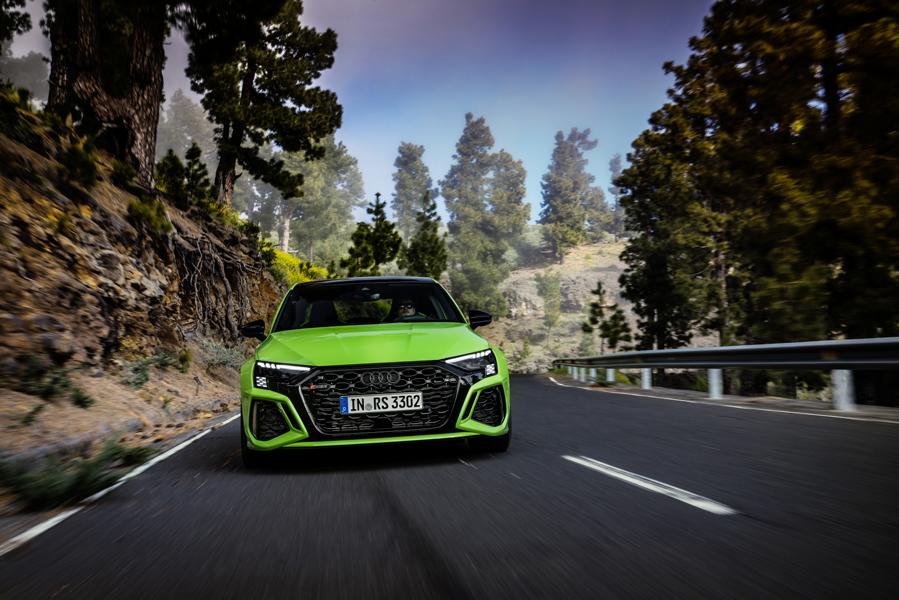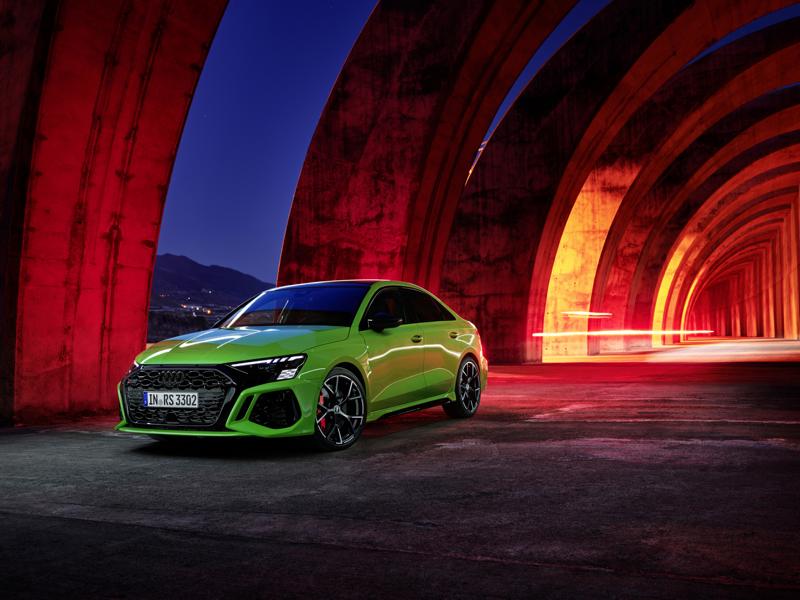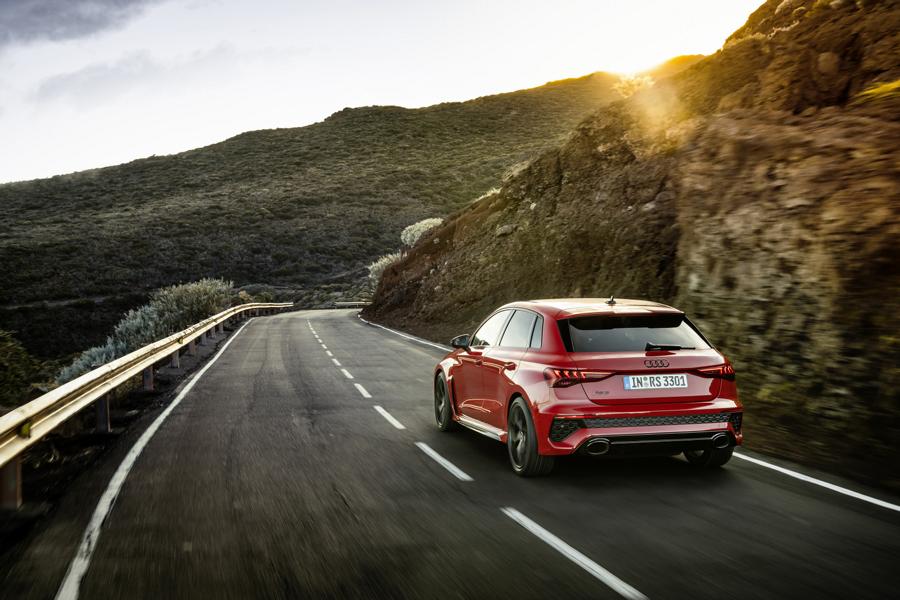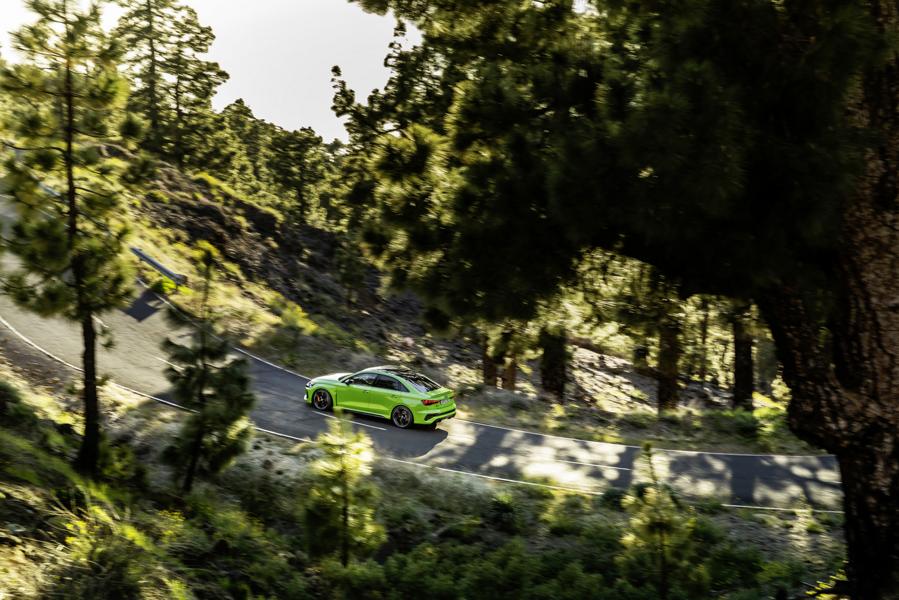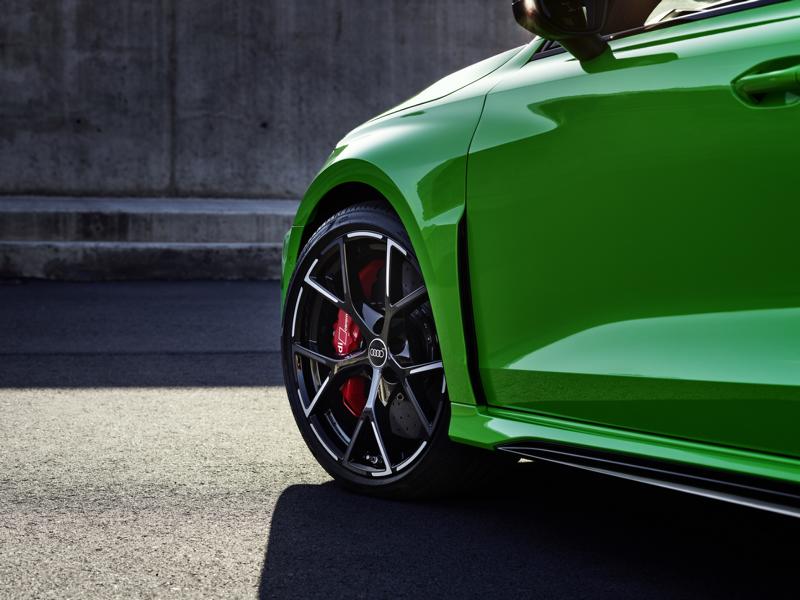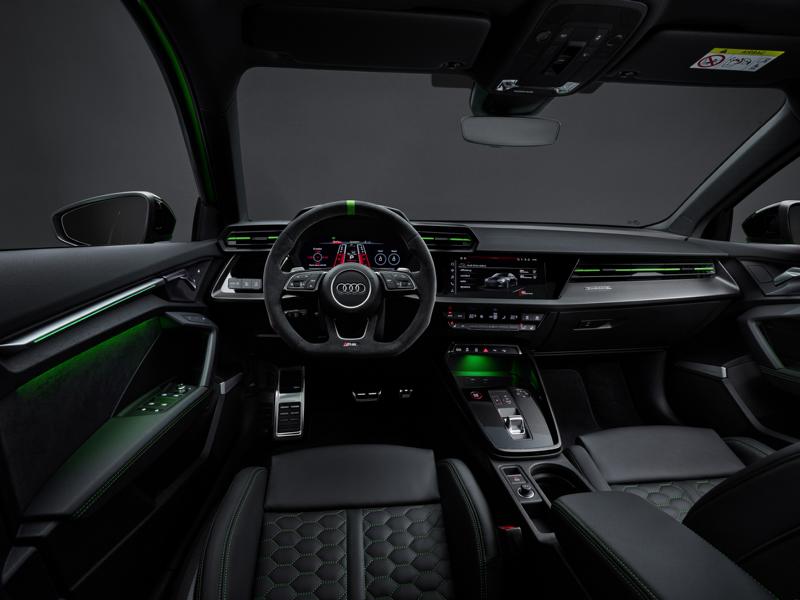The chassis: dynamism on a new level
Thanks to the quattro drive with RS Torque Splitter, two RS 3-specific drive select modes, a new braking system and semi-slick tires, the Audi RS 3 reaches a new level in terms of driving dynamics. Further extensive measures on the body and the chassis make the model a top athlete suitable for everyday use.
More across: the RS Torque Splitter
The new Audi RS 3 is the brand's first model with a torque splitter. This technology enables active, fully variable torque distribution between the rear wheels. Unlike the previous rear axle differential with an upstream multi-disc clutch package, the Torque Splitter uses an electronically controlled multi-disc clutch on each drive shaft. In this way, the right torque is continuously optimally distributed on the rear axle.
The torque splitter increases the drive torque to the rear wheel on the outside of the curve with the higher wheel load when driving in a sporty manner, which significantly reduces the tendency to understeer. In left-hand bends it directs the drive torque to the right rear wheel, in right-hand bends to the left and when driving straight ahead to both rear wheels. Due to the difference in propulsion forces, the new RS 3 turns into the curve even better and follows the steering angle more precisely. The result: maximum agility and optimal stability - especially when cornering at high speeds. The torque splitter intercepts oversteer by directing the torque to the wheel on the inside of the curve or to both wheels. If the driver takes off the accelerator, the drag torque of the engine is also distributed to the rear axle. There are also regulations in overrun that improve driving agility and stability. If a higher deceleration is initiated via the brake pedal, both clutches of the torque splitter are opened.
The Torque Splitter has its own sensor system in order to develop its effect optimally. Each of the two multi-plate clutches has its own control unit that uses the wheel speed sensors of the electronic stabilization control to measure the wheel speeds. Longitudinal and lateral acceleration, steering angle, accelerator pedal position, the selected gear and the yaw angle, i.e. the rotational movement around the vertical axis, are also influencing factors.
On the one hand, the torque splitter increases safety in everyday life, and on the other, it enables faster lap times on the racetrack. Frank Stippler, racing and development driver Audi Sport, proved the latter in June 2021 on the 20,832 km long Nürburgring-Nordschleife. At the wheel of the RS 3 sedan1 he set a new record in the compact segment with a lap time of 7: 40,748 minutes.
Race track and drift mode: new driving profiles in Audi drive select
The Audi drive select dynamic handling system comes up with two completely new RS 3-specific modes: RS Performance for the racetrack and RS Torque Rear, a drift mode for non-public roads. In addition to the familiar comfort, auto, dynamic and RS Individual modes, the RS 3 also features the efficiency mode for the first time. Depending on the selected driving profile, the character of important drivetrain and chassis components changes from comfort-oriented and consumption-optimized to distinctly sporty to race-track-specific. In addition to the torque splitter, Audi drive select also influences the engine and transmission map, the steering assistance, the electronic stabilization control, the exhaust flaps and, optionally, the adaptive chassis. Different characteristics of the systems mentioned ensure a wide spread of the driving experience.
The highest driving dynamics can be experienced in the dynamic modes and in the new RS 3-specific RS Torque Rear mode. In mode dynamic all components are designed to be sporty. The driver feels this in a more direct steering response and particularly agile handling for dynamic driving with a clearly present engine sound. There tends to be as much drive torque as possible on the rear axle. The shift processes of the S tronic are shorter, the acceleration even sportier.
The mode brings this to perfection RS torque rearthat enables controlled drifts and sporty, lateral dynamic driving. It is specially designed for closed routes. The strong rear-heavy distribution of the drive forces creates an oversteering driving behavior in that up to 100 percent of the drive torque directed to the rear reaches the outside wheel - a maximum of 1.750 Newton meters. In addition, the engine characteristic has been adapted in RS Torque Rear - even more pronounced than in dynamic mode. The same goes for the RS Performance Mode specially designed for the circuit. In both modes, the idling speed has been increased again compared to the dynamic profile to increase the starting performance. The throttle response is even more direct and implemented with pronounced load changes. In addition, drivers experience very late upshifts and early downshifts as well as optimal controllability of the linear accelerator pedal at the apex of the curve.
In addition to the specific drive setup, the RS Performance mode is also matched to the semi-slick tires from the Pirelli P Zero "Trofeo R" brand, which are available as an option for the first time. The torque splitter ensures the most neutral driving behavior possible with little understeer and oversteer in different driving situations. This enables earlier acceleration at the exit of a curve, which enables faster lap times to be achieved. The chassis has two setups for different racetracks - on the one hand, a comfortable set-up for uneven tracks such as the Nordschleife, where it is important to minimize large vertical excitations while maintaining high lateral dynamics, and on the other hand, a sporty setup for flat racetracks such as the Hockenheimring. The steering and the electronic stabilization control can also be set in the RS Performance mode in two specified characteristics.
In the driving profile auto, the mode for everyday use, there is a balanced torque distribution, that is, the RS 3 is designed to neither understeer nor oversteer. The engine and transmission map are adapted to this. In mode comfort the steering is a bit smoother, the sound of the five-cylinder more subdued, the damping behavior softer. The torque splitter ensures that the drive forces are distributed to all four wheels, with priority on the front axle. The latter also applies to the consumption-optimized efficiency-Mode. A flatter characteristic curve is stored here in the accelerator pedal. Torque and power are limited to 80 percent, with kick-down 100 percent are available. This mode also enables coasting with the engine on at idle. In mode RS Individual Drivers can set up to six systems separately in their specified characteristic curves.
For top handling: stiffened components
The body of the new Audi RS 3 makes a decisive contribution to the compact sports car's agile handling. It is ten millimeters lower than the Audi S323 and 25 millimeters lower than the A3. This reduces the center of gravity further towards the road. A McPherson strut axle with RS 3 -specific swivel bearing is installed at the front, which enables almost one degree more negative wheel camber compared to the A3. The greater inclination to the road surface, i.e. the larger angle between the wheel plane and the vertical, provides higher lateral guidance, i.e. more grip and dynamism in curves, for improved steering response. In combination with the stiffer wishbones compared to its predecessor, the RS 3 is even more agile. A 4-link construction with a separate spring-damper arrangement and subframe is used on the rear axle. The RS-specific tube stabilizer adapted to the torque splitter has a higher spring rate than in the previous model - for optimal performance. The camber is almost half a degree greater than that of the A3. All of these components also contribute to the increased lateral dynamics, as do the stiffer wheel carriers.
Precision work: the RS sports suspension
The standard RS sports suspension features newly developed, specific RS 3 dampers and valve systems. The setup of springs and dampers is decidedly tight. The specially coordinated valves ensure a particularly sensitive response behavior of the shock absorbers within the framework of the rebound and compression stage characteristics. In this way, the damping reacts even faster and more precisely to the respective driving situation.
The RS sports suspension with adaptive damper control can be ordered as an option. It adapts each damper individually and permanently to the road conditions, the driving situation and the mode selected in Audi drive select. The three characteristics comfortable, balanced and sporty ensure a clearly noticeable spread of the damper characteristics. The optimal damping force is calculated within milliseconds - low for hard bumps, high for supporting the body when cornering quickly or when braking. To do this, sensors measure the vertical acceleration of the body structure and the relative movement of the individual wheels to it. This results in increased dynamics and high driving stability with even more comfort in relation to the RS sports suspension. In RS Individual mode, the damper setting can be varied in the three characteristic curves depending on individual needs and the road conditions. In RS Performance Mode, there is a specific comfort setting for the dampers, which minimizes large vertical excitations while at the same time providing high lateral dynamics - particularly suitable for racetracks with uneven roads, such as the Nürburgring-Nordschleife.
Newly developed: 6-piston steel and ceramic brake system
Increased dynamics also means higher demands on the brakes. This is why a newly developed and larger-sized 3-piston steel brake is used in the RS 6. Its internally ventilated and perforated panes measure 375 by 36 millimeters at the front and 310 by 22 millimeters at the rear. This makes them five millimeters larger in diameter and also more stable than in the previous model. As an option, there is a 19-inch ceramic brake system measuring 380 by 38 millimeters at the front with a specially adapted pedal characteristic of the brake booster. The high-performance braking system weighs ten kilograms less than the steel brakes and offers high thermal stability, especially when used in particularly dynamic applications.
New air control elements in front of the wishbones ensure targeted air flow into the wheel arch and thus improved brake cooling. They improve the cooling time of the brakes by 20 percent. Peak temperatures at high loads are reduced more quickly while the pedal feel remains the same. The wear of the copper-free and 15 percent larger brake pads is reduced. Those who opt for the ceramic brake can choose between gray, red or blue brake calipers. Those who prefer the steel version can order red saddles instead of the black ones.
Premiere for semi-slicks ex works: the tires
The RS 3 runs on tires as standard Dimension 265/30 at the front and 245/35 at the rear, which are ten millimeters wider than the optional mixed tires on the previous model. They are mounted on 19-inch cast wheels with a 10-Y-spoke design. Alternatively there are 5 ‑ Y ‑ spokes that represent real motorsport design. Both bikes bear the RS branding. The series tires have been optimized in terms of rolling resistance through a modified profile geometry and a new rubber compound. Despite the increased width, the weight has remained the same. With the Pirelli P Zero “Trofeo R”, Audi is offering semi-slick tires ex works for the first time for particularly sporty drivers. It is specially designed for driving on racetracks, but also approved on public roads. In addition to a newly developed asymmetrical profile, the tire also has a specific rubber compound. This combination ensures a high level of grip in dry conditions. Stability and lateral support are increased again.
On board for the first time: the modular driving dynamics controller
The modular driving dynamics controller (mFDR) ensures after its first use in the Audi A3 and S323 now also in the RS 3 for faster and more precise networking of the chassis systems. As a central system, it records the data of all components relevant for the lateral dynamics and thus ensures a more precise and faster interaction between them. The mFDR synchronizes the two control units of the torque splitter and the adaptive dampers for the benefit of precise steering and driving behavior. It also influences the wheel-selective torque control and thus accesses the newly developed 6-piston steel brake or the optional RS ceramic brake. The vehicle dynamics controller demands more or less torque from the torque splitter, depending on the requirements. This further increases agility - especially on winding roads.
Intervening later: the electronic stabilization control
The electronic stabilization control (ESC) in the RS 3 was specifically tailored to the torque splitter and the new RS 3 driving modes. The ESC's sport mode is designed for the highest possible performance in the interaction of engine, transmission, quattro with RS Torque Splitter and chassis. It ensures increased driving pleasure as the ESC control intervenes later. If you keep the button in the center console pressed for at least three seconds, the ESC can also be switched off completely - useful and helpful, for example, on closed-off routes if you want to fully experience the torque rear mode.
RS-specific tuned: the progressive steering
The RS 3 has electromechanical progressive steering as standard. It varies the ratio depending on the steering angle - with increasing steering angle, the ratio becomes smaller and the steering more direct. On the one hand, this increases driving dynamics and, on the other hand, increases driving comfort through reduced steering effort. The sportier set-up, RS-specific characteristics and a more direct steering response - adapted to the chassis and tires - also ensure that the progressive steering provides close contact with the road even in fast corners. In addition, depending on the speed, it provides a precise steering feel at high speeds and ease of movement when parking or maneuvering. The basic set-up can be varied comfortably, balanced and sporty in the three characteristic curves via Audi drive select.
Safe and quiet: the body
The RS 3 Sportback4 weighs 1.570 kilograms empty without driver, the RS 3 sedan1 1.575 kilograms. The passenger cell consists of form-hardened steels. Before they are formed, they are heated to almost 1.000 degrees Celsius in an oven and then cooled to around 200 degrees in the water-cooled press tool. This extreme temperature jump results in high tensile strength. Such form-hardened steels manage with relatively small wall thicknesses and are therefore very light in terms of their strength values. These steels are used in the transition from the front end to the passenger cell, in the A-pillars, the B-pillars, the roof arch, the center tunnel, the side sills and in the floor pan. They make up around 26 percent of the body. High-strength and ultra-high-strength steel qualities are also used in the side members and in the floor of the passenger cell. The hood is made of aluminum. An aluminum profile behind the front apron serves as a crash absorber.
The acoustic glazing of the windscreen is part of the standard equipment. Other measures such as wheel arch liners made of fleece material reduce interior noise even at high speeds. The insulation behind the pillar trim, behind the dashboard and in the luggage compartment also minimizes noise.
 tuningblog.eu Your magazine about tuning the car
tuningblog.eu Your magazine about tuning the car
